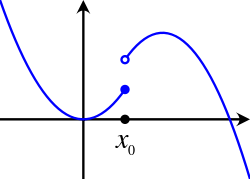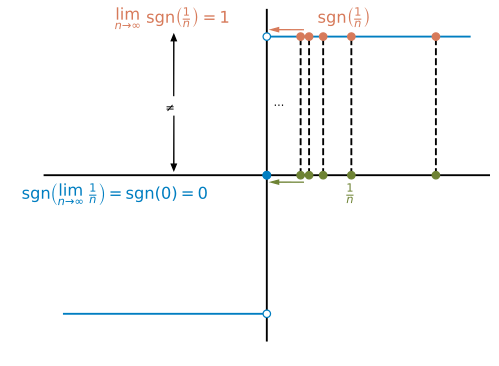Epsilon-delta definition of continuity – "Math for Non-Geeks"
Motivation and derivation
[edit | edit source]First examples
[edit | edit source]Consider the limit . In school, this limit would be calculated as follows:
Intuitively, this calculation makes sense: if , then should hold. But can we really argument like that? Why should we be allowed to "pull" the limit inside the function brackets? Let us consider another example: the sign function , which is returning the sign of :
Since there is:
So . This simple example shows that the limit may not simply be pulled into the function brackets. The function plot shows, why this worked with , but not with . For , the sequence converges to , when taking the limit :
The sign function has a "jump" in the graph at and hence, the sequence does not converge to :
We note: There are certain functions, where the limit may be pulled into the brackets, wile for other functions this may not always work.
Jumps and continuity
[edit | edit source]The reason why we cannot pull the limit into the sign function , is because its graph has a "jump" at . Let us now try to figure out, why pulling the limit into the brackets does not work, if the graph has a jump at the limit of the argument sequence. We assume to have the following graph:

When approaching from the left, the function values will also approach . So if the sequence of arguments consists only or almost only (meaning: with finitely many exceptions) of real numbers smaller or equal , then we may pull the limit inside the brackets. However, this fails if infinitely many elements bigger than appear in the sequence of arguments. Their function values will not approach , as the graph is having a jump at , when looking to the right. This jump causes a minimal distance which function values in the proximity and right of cannot fall below. The jump at prevents us from being able to pull the limit into the brackets for some sequences of arguments.
The same happens if the graph has a jump at in the left-handed direction:

Here, pulling the limit in fails whenever the sequence of arguments contains infinitely many elements smaller than . Function values left of will not approach due to the jump.
Mind that the situation may be different if is not defined at the jump:

Here, the expression does not make sense, since is not defined at . So we do not need to consider, whether pulling in the limes is allowed there. For all other real numbers, the graph of is continuous. We observe: A jump does only cause discontinuity of a function , if is even defined at the position of the jump.
Transition to a formal definition
[edit | edit source]Let us take again a function with a jump at . When approaching the argument from one side, a certain minimal distance between and will always be kept. This minimal distance between and is caused by the jump at . When approaching from the other side, the -values will come arbitrarily close to (provided there is no second jump).
For -values that should approach arbitrarily (=„infinitely“) close to , we can use the notion of a sequence. To do so, we treat the -values as a sequence , converging to . The notion of a sequence is useful, as we need usually need infinitely many -values for the approach and sequences are containing infinitely many elements as well.
Now, let us assume that we approach from the side, where our obey a minimal distance to for in the vicinity of . This minimal distance will be sustained in the limit process . In case that exists, we can therefore be sure that .
However, in our example we may also choose the sequence such that . This will, for instance, be the case when is approached by our from the other side. So in order to have , we cannot make an arbitrary choice of our sequence converging to . But we certainly know that there are sequences , for which does not tend towards .
Derivation of the sequence criterion
[edit | edit source]Let us recap what we found so far:
So if there is a jump at then we may not pull the limit inside the brackets (i.e. ) for at least one sequence of arguments converging to . Now, our intuition tells us that a function is discontinuous at some argument , whenever its graph has a jump there. Therefore, we may define:
In order to find the corresponding definition for continuity at , we just need to take the negation of the above definition for discontinuity. That means, we may understand continuity as absence of a jump, where the exact definition reads:
So we memorize: in case a function is continuous at some argument , we may pull the limit inside the brackets for any sequence of arguments convrging to . This is the sequence criterion of continuity. The entire function is considered to be continuous, if it is continuous at each argument in its domain of definition. The definition of continuity for a function therefore reads:
So let us recap: For continuous functions , we may always pull the limit inside the brackets – regardless of the limit of the sequence of arguments. For instance, the exponential function is continuous, so we may always pull the limit inside the brackets of this function. The sign function is discontinuous at , so we may not pull the limit inside the brackets, if the sequence of argument converges to zero.
Formal definition
[edit | edit source]In the above section, we already learned the definition of continuity. Let us formalize this:
Definition (Sequence criterion of continuity for a single argument)
A function with is continuous at an argument , if for all squences with and there is:
A function is said to be continuous if it is continuous at each argument:
Definition (Sequence criterion of continuity)
A function with is continuous, if for all and all sequences with and there is:
So continuity guarantees us that we are allowed to pull the limit inside the brackets. This may simplify calculations of limits tremendously - and indeed, continuity is a concept one may encounter frequently when calculating limits.
Consequences of this definition
[edit | edit source]We just found a formal definition of continuity by using our intuition of jumps. This definition turned out to be useful over the years and is therefore accepted in the mathematical community as the definition of continuity. And we will use it for the following considerations as well. So if we want to decide whether a function is continuous, we will replace our first intuition by the sequence criterion which we just found. This will also have some side effects. We consider the topological sine function:
Its graph is given by:

Our first intuition is not suitable for deciding, whether this function is continuous at , since it is oscillating here infinitely many times with the period of oscillation tending to zero. The graph itself does not look as if there would be a jump. However, using the sequence criterion of continuity, we may show that the topological sine function is discontinuous at , which corresponds to the infinitely fast oscillations (Exercise).
As a byproduct of our definition, we found a type of discontinuity differing from a jump. It is also called essential discontinuity . And we need to accept these kind of discontinuities, if we want to use the sequence criterion as a definition for discontinuities. Please note that this is one of the standard definitions in mathematics. So denying it or looking for an alternative would certainly make us some lonely outsiders in the world of mathematicians!
Examples for the sequence criterion
[edit | edit source]Quadratic functions are continuous
[edit | edit source]Math for Non-Geeks: Template:Aufgabe
Application of the sequence criterion
[edit | edit source]We have just proven that the quadratic funtion is continuous. So we may pull the limit inside the brackets without further thinking about it. This is a nice thing about continuity, as the following example underlines:
Math for Non-Geeks: Template:Aufgabe
Common sketches of proofs
[edit | edit source]Proofs of continuity using the sequence criterion
[edit | edit source]In order to prove continuity of a function at some , we need to show that for each sequence of arguments converging to , there is . A proof for this could schematically look as follows:
In order to prove continuity for the function (for all arguments in its domain of definition), we need to slightly adjust that scheme:
Proving discontinuity using the sequence criterion
[edit | edit source]In order to show that a function is discontinuous at using the sequence criterion, we need to find one specific sequence of arguments with for all which is converging to , such that the sequence of function values does not converge to . So there shall be but . In order for to hold, there are two cases to be distinguished:
- The sequence of function values diverges.
- The sequence of function values converges, but its limit is not .
Therefore, a proof of discontinuity using the sequence criterion could take the following form:
Equivalence to the epsilon-delta criterion
[edit | edit source]Math for Non-Geeks: Epsilon-delta definition of continuity
Exercises
[edit | edit source]Continuity of the absolute function
[edit | edit source]Math for Non-Geeks: Template:Aufgabe


![{\displaystyle {\begin{aligned}\lim _{n\to \infty }\exp \left({\frac {1}{n}}\right)&=\exp \left(\lim _{n\to \infty }{\frac {1}{n}}\right)\\[0.5em]&{\color {OliveGreen}\left\downarrow \ \lim _{n\to \infty }{\frac {1}{n}}=0\right.}\\[0.5em]&=\exp(0)\\&=1\end{aligned}}}](https://wikimedia.org/api/rest_v1/media/math/render/svg/9033e78c163e21a94fa543848169f60d4d2131a6)












































